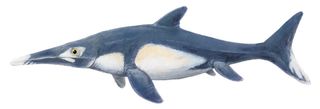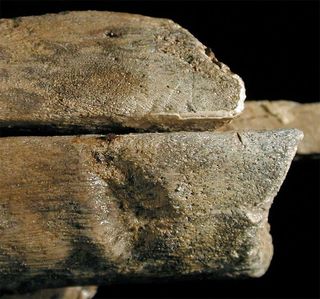Battle of Ancient Ocean Beasts Suggested by Fossil Scars

A long-snouted reptile that plied the seas some 120 million years ago, got into a scuffle that landed it with a gouged and scratched jaw -- battle wounds that are seeing the light of day, thanks to a recent discovery.
Remains of this dolphin-like sea creature called an ichthyosaur were found in the remote desert near the town of Marree in northern South Australia. Ichthyosaurs were fast-swimming predators that fed on fish and squid-like animals with their 100-plus crocodile-like teeth.
This individual, spanning about 16 feet (5 meters) in length, is a member of the genus Platypterygius.

The researchers found a gouge on the lower jaw that was about 0.9 inches long and 0.6 inches wide (23 mm by 16 mm), along with two jagged furrows and another gouge. "The bone itself was not broken, rather it was scored, suggesting that the bite was strong but not 'bone puncturing' like that of a predator," said study researcher Benjamin Kear of Uppsala University in Sweden. In fact, the researchers say this Platypterygius likely survived the brawl to live some time afterward, as the wounds showed advanced healing, including evidence a callus had formed. [Top 10 Deadliest Animals ]
When the ichthyosaur was alive, the Australian continent was still joined to Antarctica as part of the supercontinent Gondwana, and would have been much farther south than it is today, close to the southern polar circle. What is now arid grassland was then the bottom of a vast inland sea that experienced freezing water temperatures and even seasonal icebergs, the researchers say.
The researchers aren't sure what the fight may have been over or the opponent's identity, though they speculate the injuries came from a showdown with another ichthyosaur of the same species, possibly over mates, territory or food.
"The bone itself was not broken, rather it was scored, suggesting that the bite was strong but not 'bone puncturing' like that of a predator," Kear said.
Sign up for the Live Science daily newsletter now
Get the world’s most fascinating discoveries delivered straight to your inbox.
Here are the other suspects they considered:

The gigantic pliosaurid called Kronosaurus, a marine reptile that may have exceeded 33 feet (10 m) in length, was around at the time and sported a "head the size of a small car and teeth as big as bananas," Kear told LiveScience. This beast is known to have hunted very large marine vertebrates, such as big sharks of the day; however, its giant teeth would've inflicted horrific injuries, much more so than those seen on the ichthyosaur remains. Large laminar sharks have teeth that could leave parallel scratch marks, though the gouge doesn't match its feeding tendencies, the researchers say.
An accidental encounter with a small plesiosaur, whose teeth are closely spaced and conical in shape, may have left the wounds.
The finding will be detailed in a forthcoming issue of the journal Acta Palaeontologica Polonica.
Follow LiveScience for the latest in science news and discoveries on Twitter @livescience and on Facebook.

Jeanna served as editor-in-chief of Live Science. Previously, she was an assistant editor at Scholastic's Science World magazine. Jeanna has an English degree from Salisbury University, a master's degree in biogeochemistry and environmental sciences from the University of Maryland, and a graduate science journalism degree from New York University. She has worked as a biologist in Florida, where she monitored wetlands and did field surveys for endangered species. She also received an ocean sciences journalism fellowship from Woods Hole Oceanographic Institution.
